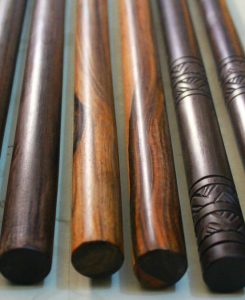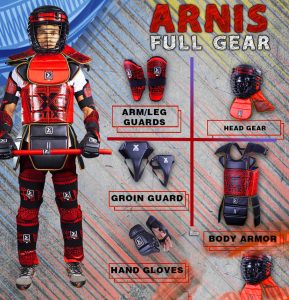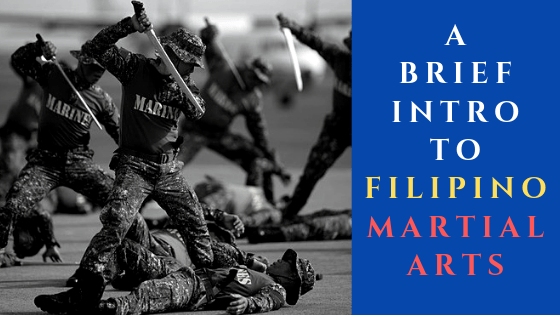Many forms of martial arts claim to be the deadliest or most potent or most superior, but none could claim to be as reliable as Arnis, Kali, and Eskrima. And since there are really very few people who can be legitimate masters of this fighting art, here are the important facts you should know to be an expert in the field.
1. Although many writers use these three terms interchangeably, their difference lies in the techniques. More specifically, the art centers on the use of a fighting stick (literally the ‘Arnis’) whether on its own (single stick), one on each hand (double stick or ‘doble’), or single/double stick combined with hands, arms and leg fighting moves.
Let’s say you are face-to-face with an attacker and all you have for a weapon is a long umbrella. If you close the umbrella, hold the handle then use the pointed end to poke your attacker in the chest and stomach to delay his attack, you are doing an Eskrima move. If you use it to strike the right leg of the attacker with the handle as he lunges at you, that is an Arnis move. Technically, that’s Strike Number 9 in Arnis. And as your attacker goes down, you can slip the umbrella under his chin then use your hands to lock and tighten the umbrella on your attacker’s neck to cut off his air supply and eventually cause him to lose consciousness so you can make your escape. That is an example of a Kali move. In these instances, you can see where the difference in the three techniques lies.
2. The key to mastery is mastering the basics of Arnis. If you are a Filipino martial arts enthusiast, you may want to consider which discipline you would like to concentrate as many masters choose only one or two. It appears that the first obvious choice is to learn the basics of Arnis before trying the other aspects of the art. What we mean to say is, you can’t be a Kali grandmaster without learning the basic Arnis moves.
3. Arnis, Kali, and Eskrima are originally defensive martial arts. This is why there is a prevalence of parry and counter moves as opposed to outright attacks that you find in some other forms of martial arts. You will also observe that there is a predominant objective to stop, immobilize, and subdue an opponent in many of the moves. This makes it very ideal as a form of self-defense but also a formidable offensive art.
4. The stick is secondary – a knowledge of the basic moves in Arnis, Eskrima or Kali is the key. You cannot always carry a bladed weapon – but a man or woman with a walking stick is welcome anywhere even in the most highly-secured areas like an airplane. A walking stick made from hardwood makes for a good Arnis only if you know the basic moves.
5. Arnis, Eskrima, and Kali also apply for bladed weapons. Although not as popular as the stick, other weapons in this martial arts form include the bolo, sword, Kris, and machete.
6. There is a right way to hold the stick. To be able to strike effectively, you should hold the stick with your dominant hand. Do not hold it at the endmost part but leave about 5-6 inches of the bottom part sticking out. Make sure that the end part does not scrape your wrist or forearm when you rotate your wrist – if it does, you’ve given the stick’s end too much allowance and this will lessen your force.
7. Your stance matters. Before you strike, always assume your fighting stance: legs spread apart for balance, body lowered for strength, free hand on chest area for defense or offense when necessary.
8. It’s not just the force of the blow but the motion of the stick. Striking with the stick should generally follow a slicing motion but with a careful aim to hit the target spot with the top end of the stick. Check out below the 12 basic strikes in Arnis below.
9. There are two kinds of force in use when striking. Arnis uses a variety of strikes as well as a degree of force that you apply when you strike. Using the correct amount of force during combat will ensure a higher chance of success.
10. Use full force when battling a bigger opponent with a stronger weapon. Striking with full force means using your body, shoulder, and arm to deliver the blow. The advantage of full force is that you can break an attacker’s bone or dislocate a joint, thereby rendering him ineffective. The downside is, it’s slower and expels more energy to execute.
11. Use a controlled tapping force when battling several opponents. Using this technique means employing primarily your arm and wrists to deliver the blow by controlled tapping of the stick. The advantage is that you can execute several strikes in a few seconds that are painful enough to hurt and slow down your opponents. It consumes less energy and because of the speed, it can be both an offensive and defensive move.
12. The Philippine wood Kamagong is perhaps the best material for Arnis. Among the many types of hardwood in the world, the Kamagong (sc. Diospyros discolor) makes for the most ideal Arnis. It’s very hard and durable and its dark color makes it look both elegant and imposing.

13. Rattan is ideal for the double stick. If you want to master the double stick, rattan is a good bet because it is light but durable. Also, if you’re after speed, this is better than the heavy Kamagong. Interestingly, rattan’s weight is fairly consistent and if you cut them in the same length, chances are, they would probably all weigh the same.
14. The 12 Strikes is a must-learn for any enthusiast. If you are serious about being a good Arnis fighter, you should master the 12 Strikes in terms of your accuracy and force. They are (standard for right-handed fighters):
12 Strikes you must learn if you're serious about Kali Arnis and Escrima
Strike 1: Left temple – with the stick held at one o’clock position, use a slashing motion with your palm pointing inward.
Strike 2: Right temple – with the stick held at eleven o’clock position, use a slashing motion with your palm pointing outward.
Strike 3: Left arm/trunk – use a slashing motion to strike any left part of the body from shoulder to hip joints
Strike 4: Right arm/trunk – use a slashing motion to strike any right part of the body from shoulder to hip joints
Strike 5: Thrust to the stomach – use a stabbing motion to hit the solar plexus then follow it up with an upward push
Strike 6: Left chest – with the palm facing outward, extend weapon arm and aim for the left chest with a stabbing motion, keeping your elbow up.
Strike 7: Right chest – with the palm facing outward, extend weapon arm and aim for the right chest with a stabbing motion, keeping your elbow down.
Strike 8: Left leg/foot/knee/shin – lower your body and hit the left leg/foot/shin/knee with your palm facing upward.
Strike 9: Right leg/foot/knee/shin – lower your body and hit the right leg/foot/shin/knee with your palm facing downward.
Strike 10: Poke to the left eye – with the palm facing outward, extend weapon arm to the left eye of your opponent, keeping your elbow down.
Strike 11: Poke to the right eye – with the palm facing outward, extend weapon arm to the right eye of your opponent, keeping your elbow up.
Strike 12: Crown attack/strike to the head – simply hack your opponent at the center of his head above the forehead.
15. A standing dummy is the best target practice for the basics. If you can’t afford the rubber and plastic training dummies on sale at your sports shop, fashion a makeshift dummy target using old car tires.
16. For double stick users, the Sinawali move is non-negotiable. This move consists of two sticks that you strike using a weaving pattern basically alternating left and right stick. The only best defense for this move is Doblete (which is similar to Sinawali). So, if you know this move and your opponent doesn’t know Doblete, you already have an advantage. In the same manner, if your opponent knows Sinawali and you don’t know Doblete, we don’t know how you will be able to defend against it aside from backing off and running away.
17. There is also a Sinawali move for single stick users. This move makes alternate strikes from the top then down and left and right. Although this is more for drills, they come in handy during fighting because it confuses the opponent keeping them unable to predict where the next strike will go.
18. Redonda is another good routine. This is also for double stick users and performs swinging the two sticks in S-shape moves above the hips and over the head. It’s good exercise for coordination and flexibility.
19. 300 strikes per minute are NOT overspeeding. Yes, you read right: 300 strikes per minute is what you should aim for. It’s going to take a lot of work so don’t give up too easily. Try to balance speed with force and accuracy.
20. Tournament rules outlaw certain moves. Players can use hits and slashes only. You cannot use your stick to poke or stab your opponent.
21. You can’t use your hand freely in a tournament. Striking will only involve the stick and feet (yes, kicking the upper part of the body is okay) but no striking with the hand. Unless…
22. You can hold your opponent’s stick for a second. In tournaments, you can do an instantaneous “Hold and Hit” where you (if you have the chance) grab and hold the opponent’s stick to immobilize it then strike your opponent right after. However, you must release the opponent’s stick immediately.
23. You win by scoring points or disarming your opponent. Three judges score the bout using a “10-point must system”, so make sure you get a lot of strikes against your opponent. Disarming your opponent 3 times in one round makes you an automatic winner.
24. Safety gear is mandatory for tournaments. These are the following:
a. Headgear or helmet
b. Armored or padded gown
c. Protective full fingered gloves or fighting gloves
d. Elbow pads, forearm pads, knee pads, protective cup, and shoes

25. Tournament participants can only use rattan sticks for their protection. So, if you are aiming to win medals from contests and tournaments, practice using rattan sticks. Kamagong sticks are too lethal for tournaments so game officials do not allow it.

26. Bowing or salute is mandatory before and after each bout. Before the bout, participants salute to the judges then to each other. After the bout, the contestants salute to the judges again and then to each other. This is an honorable sport despite its fierce and fast nature.
27. If you’re not going to use your knowledge of Arnis for competition or fighting, it’s a good exercise nonetheless. Arnis, Eskrima, and Kali work out your whole body and practically all muscles so it’s good for physical fitness. It builds your stamina, tones your muscles, and gives you flexibility, strength, and balance – all in one regimen.
28. Ranks of martial artists in Arnis is very literal. Basically, you start with no degree and then you move up to “Isa” or one then progress to “Dalawa” or two. The highest degree is “Labingisa” or eleven. A word denoting your gender comes before your degree. If you are male, you are ‘Lakan’ (ex. Lakan Isa) or if you are female, you can be ‘Dayang’ (ex. Dayang Dalawa).
29. The length of the sticks does not really adjust according to the height of the user. Children and adults basically use the same size and length of sticks. If you’re a Shaquille O’Neal, you’ll still be using the same length of the stick.



